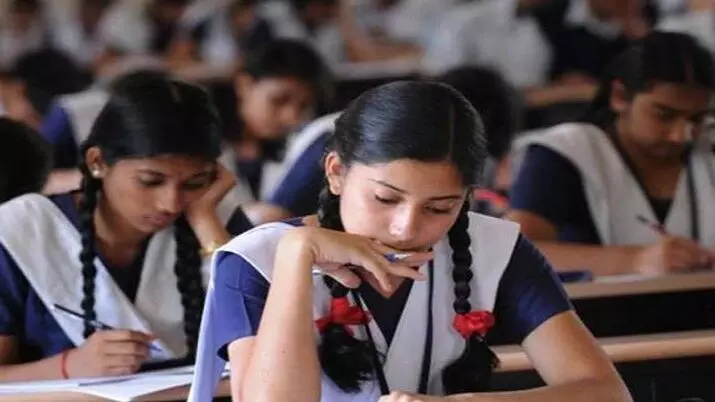TRENDING TAGS :
Normal Exams, Abnormal System: The Flaws of India’s Education and Recruitment Process
An eye-opening critique of India’s examination system by journalist Yogesh Mishra, exposing how normalization, outsourcing, and commercialization undermine fairness and trust in public sector recruitment.
Exam (pc- social media)
First to study, then to pass, and finally to secure employment. Examinations have transformed into battlegrounds, with protests and legal battles becoming commonplace. Rarely does an examination proceed without controversy, especially those conducted by government agencies for public sector jobs.
Scrutiny of state-level public service commissions
Currently, state-level public service commission exams are under scrutiny, particularly in Uttar Pradesh and Bihar, where the demand for government jobs is immense. Accusations of bias, casteism, and delayed schedules have long plagued these commissions. However, the current uproar centers around the “normalization” process. This method adjusts scores when exams are conducted in multiple shifts with different question sets. While intended to ensure fairness, it can result in score reductions for some candidates and increases for others, leading to widespread dissatisfaction.
Normalization is not unique—its spread across examinations
This normalization isn’t unique to state public service commissions; it’s prevalent in exams like NEET, CLAT, police recruitment, and railway recruitment. The justification often cited is the logistical challenge of accommodating a large number of candidates in a single shift. However, this reasoning appears weak. For instance, the Uttar Pradesh Public Service Commission, established in 1937, and the Bihar Public Service Commission, established in 1949, have had decades to develop infrastructure capable of handling large-scale examinations.
Capacity of universities and missed opportunities
Uttar Pradesh boasts over 55 universities and approximately 7,500 degree colleges. If each institution accommodates just 50 candidates, the logistical challenge diminishes significantly. Yet, examinations are confined to select centers, often operated by private entities focused solely on the examination business. Authorities argue that outsourcing minimizes malpractice, but this approach raises questions about accountability.
The Bihar experience and national parallels
Bihar faces similar issues. Despite having 39 universities and 200 degree colleges, it struggles to conduct single-shift examinations, citing space constraints. This reasoning extends to national-level exams like NEET and CLAT.
The outdated system amidst a changing employment landscape
It’s perplexing that despite a decline in government job vacancies, a shift towards startups and self-employment, an increase in students studying abroad, and a growing inclination towards private sector careers, the examination system remains outdated and inefficient.
China’s example: Efficient and large-scale examinations
Contrastingly, China, with a comparable population, conducts its national qualifying exams for higher education with remarkable efficiency. This year, approximately 15 million students participated, with examination centers set up in stadiums, large auditoriums, and football fields. Comprehensive arrangements, including security and emergency services, ensure smooth execution—a feat achieved annually without significant issues.
India’s testing agencies under constant suspicion
In India, agencies like the National Testing Agency, public service commissions, and railway recruitment boards often find themselves embroiled in controversies. Uttar Pradesh, with a population exceeding 240 million, struggles to conduct exams for 4 to 5 lakh candidates without complications. The normalization process, especially in exams where a single mark can determine success, adds to the stress of candidates and their families.
The NEET example and coaching-led protests
Take NEET, for example. Issues ranging from question paper leaks to court cases have plagued the examination. Coaching centers, sensing the unrest among students, have begun leading protests—a new trend now observed in public service commission exams as well.
Commercialization of the examination process
The root cause of these issues is the commercialization of the examination process. From center allocation to exam organization, outsourcing has become the norm, involving substantial financial transactions. A parallel industry thrives on facilitating exam success, often linked to officials. Malpractices like paper leaks, answer sheet manipulation, and coaching center profiteering are rampant, involving hundreds of crores of rupees. In such an environment, there’s little incentive to reform the system.
Mistrust and disillusionment
Consequently, every examination and the agencies conducting them are viewed with suspicion. Despite witnessing numerous scandals—from the Vyapam scam in Madhya Pradesh to irregularities in the Uttar Pradesh Assembly Secretariat and police recruitments—lessons remain unlearned. Candidates, disillusioned by the system, either resign themselves to the chaos or seek opportunities abroad.
From Human Resource Development to systemic exclusion
At one point, the Ministry of Education was known as the Ministry of Human Resource Development, emphasizing the value of every individual as a national asset. Students, being integral to this human resource, deserve a system that nurtures and supports them. Unfortunately, the current apparatus seems indifferent, systematically excluding both talent and trust.


